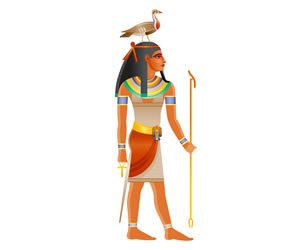Geb is the Egyptian god of the Earth. He is also a god of fertility and farming, and is associated with birth, death and the life cycle in Egyptian mythology. Geb is also sometimes referred to as “seb” or “keb”. There is some debate over the proper pronunciation and spelling of his name, as well as when different variants of his name were used in ancient Egypt.
Quick Facts about Geb
- Depending on the belief system, Geb had four or five siblings, and they were born from Shu and Tefnut.
- One mythological narrative has Atum becoming angry at Nut and Geb. He curses them so that they can’t have any children in any month. Thoth, the god of knowledge, cunningly adds five days to the lunar calendar to form a new calendar, and the two siblings then had 5 children. This mythological story explained why there were 365 days in a calendar year.1
- An Egyptian Pharaoh or king was known as an ‘heir of Geb’. The god was important during the transfer of power from one Pharaoh or king to the next.2
- In hieroglyphics, the goose was used to spell the beginning of Geb’s name.
Origins
The oldest known depiction of Geb is found in Heliopolis, and is dated to approximately 2600 B.C.E.
Geb was incorporated into the Great Ennead of Heliopolis. Ennead is a Greek term for the number nine, and its meaning relating to Egyptian mythology is “a collection of nine deities”. There were a number of Enneads, or collections of nine deities, created in ancient Egypt at various points of the civilization. The Great Ennead is the most famous of those collections.
The Great Ennead was formed as early as 2600 – 2500 B.C.E. The other eight members of this particular grouping included Atum, Shu, Tefnut, Nut, Osiris, Isis, Seth and Nephthys.
Appearance
In hieroglyphic writings, Geb was usually portrayed in a purely human form. In many of these portrayals, he can be seen covered with plants or vegetation to symbolize fertility in farming. He was sometimes depicted as having green hair or skin, and also at times shown with a goose sitting on top of his head.
He was also shown lying on the ground underneath Nut who was arched high above and covered with stars, or underneath Shu who was between him and Nut.
One example of this is found on the Papyrus of Tentamun, and can be found in other papyrus writings as well. Geb can also at times be found in scenes in a zoomorphic or hybrid form, such as having a snake’s head and human body.
Family
His parents were Tefnut, known as the moisture goddess, and Shu, the god of sunlight, wind and air. Geb also had a twin sister, Nut, who was goddess of the sky.
Geb and Nut produced four offspring – Seth, god of storms and disorder, and Osiris, Isis, and Nephthys. At times they were said to have a fifth child, Horus.
According to the Heliopolitan Ennead system, Geb had an important place in the creation story. Some time after he and his sister were born, they began to have a relationship that was incestual. Their father, Shu, was not pleased with them and separated them. Shu held Nut up above his head in the sky, and kept Geb on the earth below him.
In the space between them, Shu created and gave life to nature.1 Even though they were separated, the siblings still had four (or five) children together. Narratives between cities and regions may have differed from this, but many of them had the father Shu holding or supporting Nut and standing on top of Geb.
As a result, Geb became very important to matters relating to the earth. It was said that earthquakes were the result of his laughter. Because of this relation to the earth, he became an important god in farming.
Symbols
Animals associated with him included geese, snakes, rabbits, bulls. Other symbols that were affiliated with him included plants such as grain or reeds.
Worship
There was not a major cult center associated with Geb, but the god did have a high number of appearances in hieroglyphics throughout Egyptian temples, tombs and pyramids. Heliopolis, located near Cairo, is one such place where Geb frequently appears.2
More Geb Facts
| Name(s): | Geb |
| Rules over: | Earth, Fertility, Farming |
| Gender: | Male |
| Symbols: | Reeds, Grain |
| Sacred animals: | Goose, Snakes, Rabbits, Bulls |
| Parents: | Shu (Father) and Tefnut (Mother) |
| Siblings: | Seth, Osiris, Nephthys, Isis, Horus |
| Greek Similar: | Gaea, goddess of the earth. |
| Roman Similar: | Terra Mater |
References
- 1. Schomp, Virginia. “The Ancient Egyptians”, 2007. Marshall Cavendish Publishing.
- 2. Wilkinson, Toby. “The Egyptian World”, 2007. Routledge.


























